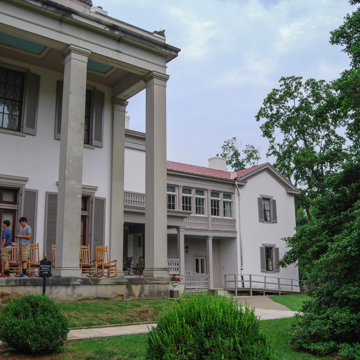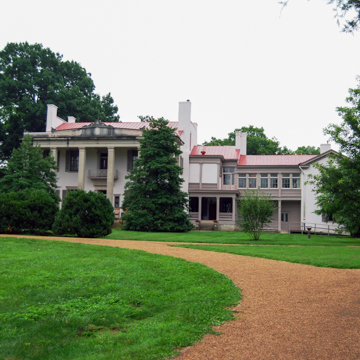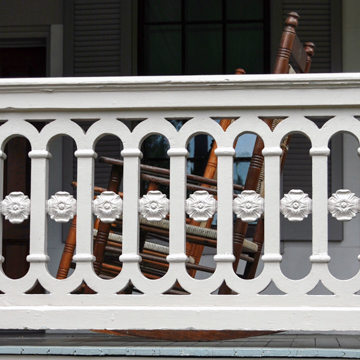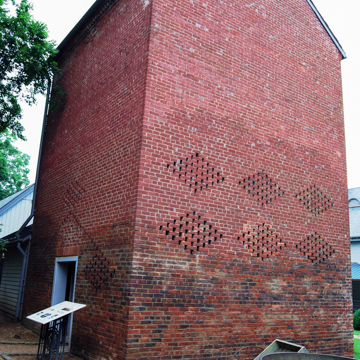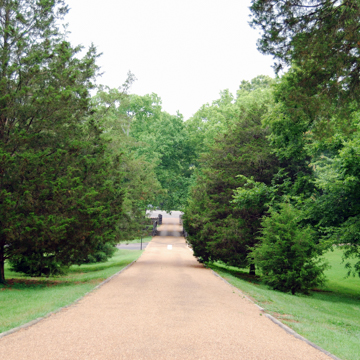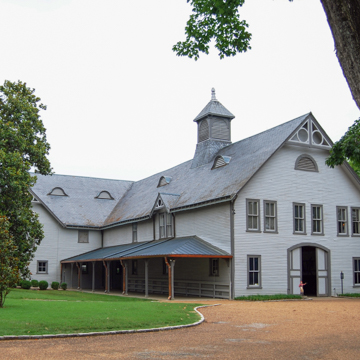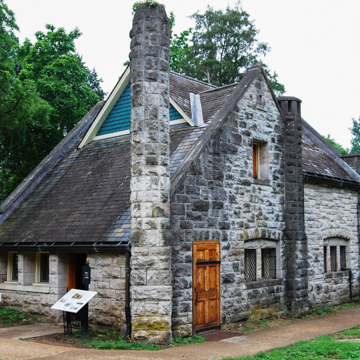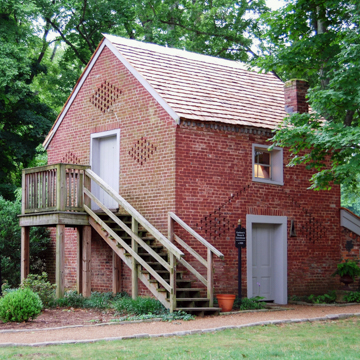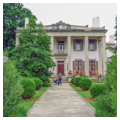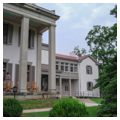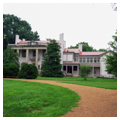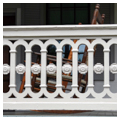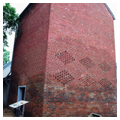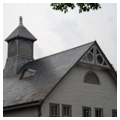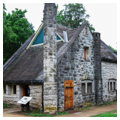You are here
Belle Meade Plantation
Around 1807 John Harding (1777–1865) moved from Virginia to establish Belle Meade Plantation along the bank of Richland Creek, several miles west of what was already downtown Nashville. At first Harding lived in a log house on the property, but in 1819 he started to acquire brick, shingles, and household goods for a new residence built in the Federal style. Two decades later, John Harding, now a successful farmer, businessman, and horse breeder, turned over management of the plantation to his widowed son, William Giles Harding (1808–1886) in 1839. William enlarged the house in the early 1840s but it was only in 1853–1854 that Belle Meade took on its present Greek Revival appearance.
The modifications made to the mansion between 1853 and 1854 were extensive. In addition to the creation of attic space and the raising of the ceilings, a two-story addition with a basement was appended to the house. On the main floor, a front parlor and library were built. Gable end chimneys were also added. Most monumentally, a pedimented portico was added to the facade. The pillars are twenty-two feet tall and each consists of two massive stones quarried on the plantation. Exterior brick walls were sheathed in stucco to unify the old and new parts of the house. The result was a cohesive Greek Revival mansion.
Harding enhanced the mansion’s interior with a cantilevered stair in the main hall, heart pine flooring, and ruby color glass transoms. Nashville’s Union and American called the house one of the best in the country, and while it described Belle Meade as spacious and elegant, the newspaper noted that, “the massive towering stone pillars…impress one more with the idea of extravagance than utility.” The grounds were equally impressive, and contained a deer park stocked with deer, elk, and buffalo.
A brigadier general in the Tennessee State Militia, and a staunch supporter of the Confederacy, William Giles Harding was arrested in early 1862 and imprisoned in Fort Mackinac soon after Union troops occupied Nashville during the Civil War. He was pardoned six months later. By war’s end the plantation was kept up by former slaves who worked as contract labor. In 1868 Harding’s daughter Selene married William Hicks Jackson. The couple lived at Belle Meade and Jackson worked with Harding to manage the plantation. Jackson modernized the house in the 1880s, adding bathrooms, hot and cold running water, and a telephone.
During the nineteenth century, Belle Meade was known not only for the beauty of the mansion and grounds, but as an important stud farm. Thoroughbred breeding began on the plantation as early as 1816 and Belle Meade’s reputation for breeding grew immensely in the 1840s and 1850s. But it was after the Civil War that Belle Meade became famous internationally for its thoroughbred stock. The French government sent representatives in 1881 to inspect American thoroughbred breeding farms and they reported that Belle Meade far surpassed anything they had seen in the United States or France. Bonnie Scotland and Iroquois were two of Belle Meade’s notable sires in the 1880s. In 1881, Iroquois was the first American thoroughbred to win the English Derby. The Thoroughbred Horse of the Year title was not begun until 1937, but from then until 1986, forty-two of the fifty champion thoroughbreds were descended from Bonnie Scotland.
By the early 1890s Belle Meade had grown to over 5,000 acres, but the Panic of 1893 and a late Victorian outcry against gambling on horse racing resulted in loss of income for the plantation. The Harding-Jackson family began to sell off its acreage, finally giving up the house and remaining land around 1904. The property changed hands and continued to be subdivided until the State of Tennessee purchased the house and the last twenty-four acres in 1953. The State then deeded Belle Meade to the Association for the Preservation of Tennessee Antiquities, which continues to own and manage it. Today, the property is operated as a historic house museum and event site with the former plantation house as the centerpiece.
References
“The Architecture of Belle Meade.” Belle Meade Plantation. Accessed March 30, 2018. http://bellemeadeplantation.com/.
Brandau, Roberta Sewell, ed. History of Homes and Gardens of Tennessee. Garden Study Club of Nashville, 1936. Reprint, Nashville: Friends of Cheekwood, 1964.
Cochran, Gifford. Grandeur in Tennessee. New York: JJ Augustin Publishers, 1946.
Coop, May Dean, “Belle Meade,” Davidson County, Tennessee. National Register ofHistoric Places Inventory–Nomination Form, 1969. National Park Service, U.S. Department of the Interior, Washington, D.C.
Gower, Herschel. “Belle Meade: Queen of Tennessee Plantations.” Tennessee Historical Quarterly(September 1963): 203-222.
“History.” Belle Meade Plantation. Accessed March 30, 2018. http://bellemeadeplantation.com/.
Hoagland, Alison K., “Belmont, Belmont Boulevard & Wedgewood,” Davidson County, Tennessee. Historic American Buildings Survey, 1981. National Park Service, U.S. Department of the Interior, Washington, D.C.
Hoobler, James A. “Karnak on the Cumberland.” Tennessee Historical Quarterly(Fall 1976): 251-262.
Kreyling, Christine, Wesley Paine, Charles W. Warterfield, Jr., and Susan Ford Wiltshire. Classical Nashville: Athens of the South.Nashville: Vanderbilt University Press, 1996.
Patrick, James. Architecture in Tennessee, 1768-1897.Knoxville: University of Tennessee Press, 1981.
Wills, Ridley II. “Belle Meade Plantation.” Tennessee Encyclopedia of History and Culture. Version 2.0, Online Edition. Nashville: Tennessee Historical Society, 2000–2018. http://tennesseeencyclopedia.net/.
Wills, Ridley II. The History of Belle Meade: Mansion, Plantation, and Stud. Nashville: Vanderbilt University Press, 1991.
Wills, Ridley II. “William Giles Harding.” Tennessee Encyclopedia of History and Culture. Version 2.0, Online Edition. Nashville: Tennessee Historical Society, 2000–2018. http://tennesseeencyclopedia.net/.
Writing Credits
If SAH Archipedia has been useful to you, please consider supporting it.
SAH Archipedia tells the story of the United States through its buildings, landscapes, and cities. This freely available resource empowers the public with authoritative knowledge that deepens their understanding and appreciation of the built environment. But the Society of Architectural Historians, which created SAH Archipedia with University of Virginia Press, needs your support to maintain the high-caliber research, writing, photography, cartography, editing, design, and programming that make SAH Archipedia a trusted online resource available to all who value the history of place, heritage tourism, and learning.















